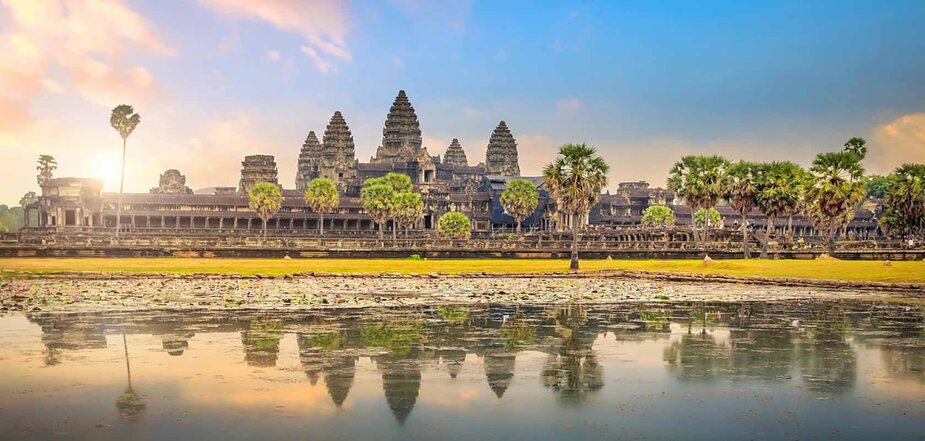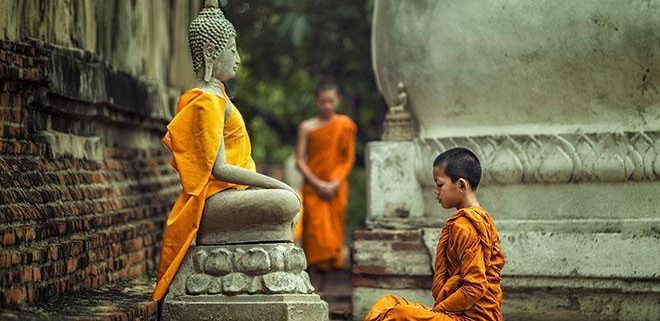1. About Cambodia Culture
Cambodian culture, also known as Khmer culture, is a vibrant tapestry woven with the threads of history, tradition, and spiritual beliefs. From the awe-inspiring temples of Angkor Wat to the graceful movements of traditional dance, Cambodia’s cultural treasures encompass various art forms, culinary delights, festivals, and social customs. So, traveling to Cambodia will bring you much deeper knowledge about Cambodian culture.
See more:
2. The Rich Heritage Of Cambodian Culture
2.1. Religion
2.1.1. Buddhism
The percentage of Buddhism in Cambodia is over 90% of the population. This information is reflected explicitly in the 4,400 temples and pagodas nationwide. And Cambodian religious practices and rituals are deeply ingrained in their everyday life.

2.1.2. Hindu, Muslims, Jews, Cao Dai adherents and others
The remaining 7 percent of the population includes Christians, Muslims, animists, Baha’is, Jews, and Cao Dai adherents. This diverse religious tapestry adds another layer of richness and variety to the country’s cultural mosaic.
2.2. Khmer Empire Legacy
2.2.1. Angkor Wat
Built during the height of the Khmer Empire in the 12th century, Angkor Wat (in Sieam Reap province) was originally constructed as a Hindu temple dedicated to the god Vishnu. It later transitioned into a Buddhist temple and remains a religious site nowadays. Specifically, this place, also a UNESCO World Heritage site, symbolizes Cambodia and is considered one of the greatest architectural achievements in Southeast Asia.

2.2.2. Other highlight architectures
Cambodia has a rich cultural heritage, and you may encounter statues and symbols related to the ancient Khmer kingdom, the nine-headed Naga snakes lying all over the road and alleys. Besides, The temples of the Khmer Empire are known for their distinctive spire architecture and intricate carvings. The carvings often depict various scenes from mythology, religious narratives, and aspects of daily life during the Khmer Empire.

2.3. Traditional Arts And Crafts
2.3.1. Dances
Cambodian traditional performing arts, including the Apsara dance, folk dance, and Sbek Thom, are integral parts of the country’s cultural heritage. These art forms have been passed down through generations and hold deep significance in Cambodian culture. Additionally, with its distinct instruments like the Roneat, Tro, and Skor thom, Cambodian classical music complements these performances.

2.3.2. Crafts
Traditional crafts in Cambodia, such as silk weaving, silver processing, and wood carving, are highly valued for their cultural significance and association with Khmer identity and royal style. These crafts have been practiced for generations, with artisans honing their skills and passing them down through their families.

2.4. Cuisine
Although Indian and Chinese styles have influenced Cambodian cuisine, it has developed its own unique flavors and characteristics. Cambodian dishes often balance sweet, sour, salty, and sometimes spicy flavors, utilizing local ingredients such as lemongrass, galangal, and fish sauce.

2.5. Traditional Clothing
Traditional clothing in Cambodia is usually the Sampot, the country’s national garment. The Sampot is a rectangular piece of fabric that is typically worn as a wrap-around skirt. It is made from silk, cotton, or other fabrics and comes in various colors and patterns. You can find out many clothes stores right in the Cambodia capital city – Phnom Penh.

2.6. Festivals
2.6.1. Bom Chaul Chnam
Bom Chaul Chnam is the Water Festival, which takes place from April 13th to 15th. People gather in the streets and near rivers to engage in friendly water fights using buckets, water guns, or simply splashing water on one another. This cleansing symbolizes washing away bad luck and misfortunes from the past year and welcoming a fresh start.

2.6.2. Meak Bochea
Meak Bochea is an important Buddhist religious holiday celebrated in Cambodia, as well as in other Southeast Asian countries. It falls on the full moon day of the third lunar month. Meak Bochea commemorates a significant event in the life of the Buddha and serves as a day of religious observance and reflection for Buddhists.
2.7. Cultural communications
2.7.1. Hands clasped in front of chest
The traditional greeting of the Cambodian people is to bow with hands clasped in front of the chest, similar to praying in Buddhism. If they want to show respect to the other person, they will bow lower and their hands clasped in a higher position.

2.7.2. Shake hands
Handshakes are often used when greeting foreigners, especially in more urban and cosmopolitan areas, as Cambodians are aware of Western cultural norms.
2.8. Tips when travel to Cambodia
Respond to every greeting you receive from Cambodians.
Do not pat children’s heads because Cambodians think it’s an action only gods and the children’s parents are allowed to do.
If you are in a temple or Khmer home, you should be careful not to cross your legs but instead sit with both feet on one side.
3. Cambodian culture is truly the heritage of Khmer people
Overall, Cambodian culture is a blend of ancient traditions, religious practices, artistic expressions, and cultural customs that have shaped the identity and heritage of the Khmer people. It is a fascinating and diverse culture that continues to thrive and evolve, embracing its past while adapting to the influences of the modern world. Metta Voyage hopes the information will give you an overview of Cambodian culture when traveling to Cambodia.
Contact us
Website: mettavoyage.com
Email: info@mettavoyage.com
Hotline 24/7: + 84 989 383 572



0 Comment